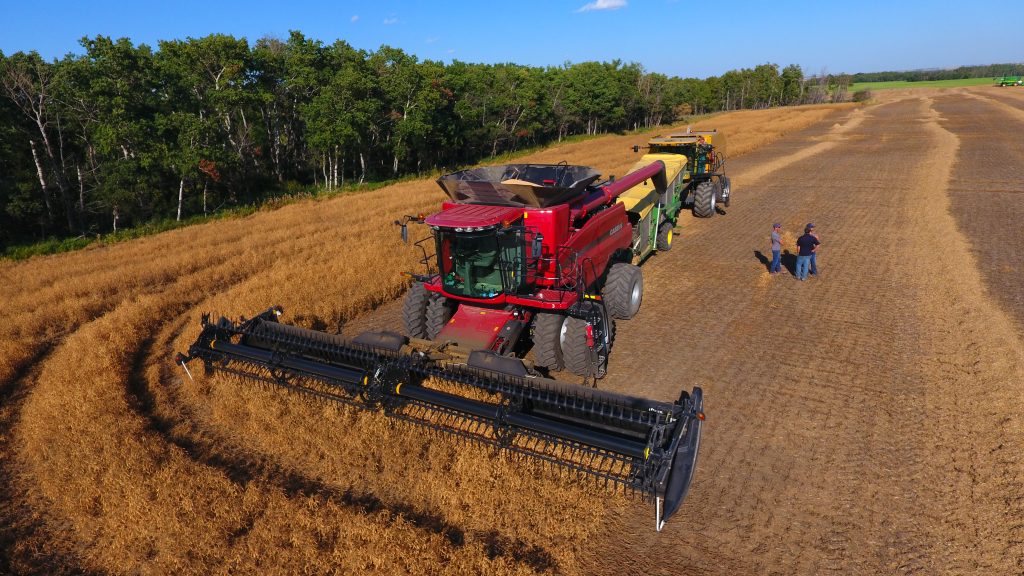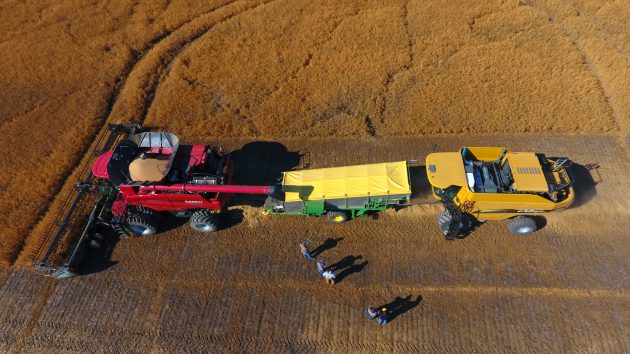
Features
Combines/Harvesters
Harvesting
Lost in translation: converting grain loss signal into grain loss rate
Although new technology and tools continue to advance in many aspects of farming, grain loss monitoring has seen minimal improvements since its introduction in the mid-’70s. Research is underway to improve grain loss monitoring, and hopefully, decrease harvest losses as a result of better feedback.
May 30, 2019 By Donna Fleury
 The results showed that under most conditions, the grain loss monitor system is still an important tool for farmers to use during harvest to manage grain losses. Photo courtesy of PAMI.
The results showed that under most conditions, the grain loss monitor system is still an important tool for farmers to use during harvest to manage grain losses. Photo courtesy of PAMI. Current loss monitoring technology displays bar graphs or numerical values without a unit of measurement, making it difficult for the operator to adequately quantify the losses. Improvements to grain loss sensor signal presentation to meaningful units of absolute grain loss would help operators and farm managers make improved economic decisions and better manage grain loss during harvest.
“We initiated a project in 2017 to investigate the feasibility of converting a combine’s grain loss signal into a grain loss rate to determine if harvest losses could be decreased across all Saskatchewan crops through improved harvest loss feedback,” says Zach Kendel, project lead with Prairie Agricultural Machinery Institute (PAMI) in Humboldt, Sask. “Our main objective was to determine the correlation between existing harvester loss sensor output with actual grain loss by putting the harvester loss signal and the actual grain loss rate in relation. Using a combination of lab testing and field tests with farmer cooperators using full-scale harvest and test equipment, the project also evaluated existing technology to determine if it is adequate to support a grain loss rate, as well as efforts for optimization of the harvest loss sensors.”
Testing the reliability of grain loss monitor systems
Three crops, including peas, wheat and canola, were compared in both lab and field testing. In the lab tests, grain kernels of varying size and frequency (simulating high and low loss scenarios) were dropped on to combine loss sensors to determine the loss signal characteristics such as amplitude, impact signal frequency and signal resolution. These lab characteristics were then translated into methods of properly recording the loss signal during field testing.
In the field testing, both actual grain loss and the loss sensor signal information (cleaning shoe and separator) were collected from a combine in the three crops over a range of feed rates to create loss curves. The test equipment included a collector that was pulled behind the combine to capture all the material (straw, chaff, and grain) discharged from the rear of the combine over a set distance, and a processor used to clean the grain from the captured material to determine the actual grain loss from multiple test collections. Relationship equations were used to graphically compare the grain loss curve and loss sensor signal curve.
“In our final analysis of the data collected in 2017, we found that although existing grain loss sensors on combines are a good indicator of grain loss, there still wasn’t any way to currently correlate that to actual grain loss numbers,” Kendel explains. “However, we were surprised at how good the correlation to actual loss was for larger sized grain crops like peas, but for smaller grains like canola and wheat, it was not as great. In small grain crops, design improvements would need to be made to the grain loss sensor system, to accurately indicate actual grain loss rate, especially on the cleaning shoe loss sensor.
“Overall, the results showed that under most conditions, the grain loss monitor system tested did provide a reliable indication of when actual loss was increasing or decreasing, and therefore, is still an important tool for farmers to use when they are in the field at harvest to manage grain losses.”

Determining actual grain loss in field tests, using full-scale harvest and test equipment, including a collector pulled behind the combine and a processor. Photo courtesy of PAMI.
Comparing other sensing technologies
As part of the project, a variety of other sensing technologies were investigated including accelerometers, microphones, microwave, photoelectric, and ultrasonic sensors to determine if any could be implemented to better support a grain loss rate. Although some of these technologies showed promise in their ability to detect grain loss, further research, development and testing would be required to determine their full capabilities.
“Our results confirm that grain loss monitors are still a good tool for providing an indication of grain loss even if they can’t be correlated to specific measures,” Kendel notes. “Although it takes a bit of time, we recommend that farmers take the time to calibrate and adjust settings, and to get out and drop a pan to see what the losses are and how that equates to the loss signal on the combine monitor. Depending how much is thrown over by the combine, this can have a significant economic impact on the final harvest profits. Slower speeds are still recommended, and a good rule of thumb is that faster speeds will result in higher losses.”
The future of grain loss monitoring
Although PAMI does not currently have any new projects planned in this area, some future research and development opportunities were identified in the project. For example, determining how the relationship equations between the loss sensor signal and actual loss rate change depending on combine make/model and/or crop type and condition, is important.
“With existing technology, some advancements to consider could be altering the position of the sensors on the cleaning shoe or on the rotor to get more accurate numbers,” Kendel says. “Another important area of further investigation is real-time monitoring of feed rate during harvesting operations because we need to know this rate for the relationship equations to accurately display a grain loss rate. Advancements and improvements in the technology will provide more meaningful feedback and information to enable farmers make economic decisions and maximize profits.”